2014 BMW 650I XDRIVE GRAN COUPE parking brake
[x] Cancel search: parking brakePage 117 of 243

Driving stability control systemsVehicle equipmentAll standard, country-specific and optional
equipment that is offered in the model series is
described in this chapter. Therefore, equip‐
ment is also described that is not available in a
vehicle, e. g., because of the selected optional
equipment or country variant. This also applies
for safety-related functions and systems.
Antilock Brake System ABS ABS prevents locking of the wheels during
braking.
The vehicle remains steerable even during full
brake applications, thus increasing active
safety.
ABS is operational every time you start the en‐
gine.
Brake assistant
When you apply the brakes rapidly, this system
automatically produces the maximum braking
force boost. This then reduces braking dis‐ tance to a minimum during full braking. This
system utilizes all of the benefits provided by ABS.
Do not reduce the pressure on the brake pedal
for the duration of the full braking.
When equipped with Driving Assistant Plus or
with Active Cruise Control with Stop & Go
function, ACC is supported by the braking in‐
tervention if there is a possible risk of collision.
To do this, the braking force is automatically increased if the braking pressure is insufficient
when the brakes are applied.Adaptive brake assistant
In combination with the Active Cruise Control,
this system ensures that the brakes respond
even more rapidly when braking in critical sit‐
uations.
Drive-off assistant
This system supports driving away on gradi‐
ents. The parking brake is not required.1.Hold the vehicle in place with the foot
brake.2.Release the foot brake and drive away
without delay.
After the foot brake is released, the vehicle is
held in place for approx. 2 seconds.
Depending on the vehicle load, the vehicle may
roll back slightly.
Driving off without delay
After releasing the foot brake, start driv‐
ing without delay, since the drive-off assistant
will not hold the vehicle in place for more than
approx. 2 seconds and the vehicle will begin
rolling back.◀
DSC Dynamic Stability
Control
The concept DSC prevents traction loss in the driving
wheels when driving away and accelerating.
DSC also recognizes unstable vehicle condi‐
tions, such as fishtailing or nose-diving. Sub‐
ject to physical limits, DSC helps to keep the
vehicle on a steady course by reducing engine
speed and by applying brakes at individual
wheels.
Seite 117Driving stability control systemsControls117
Online Edition for Part no. 01 40 2 909 877 - VI/13
Page 128 of 243
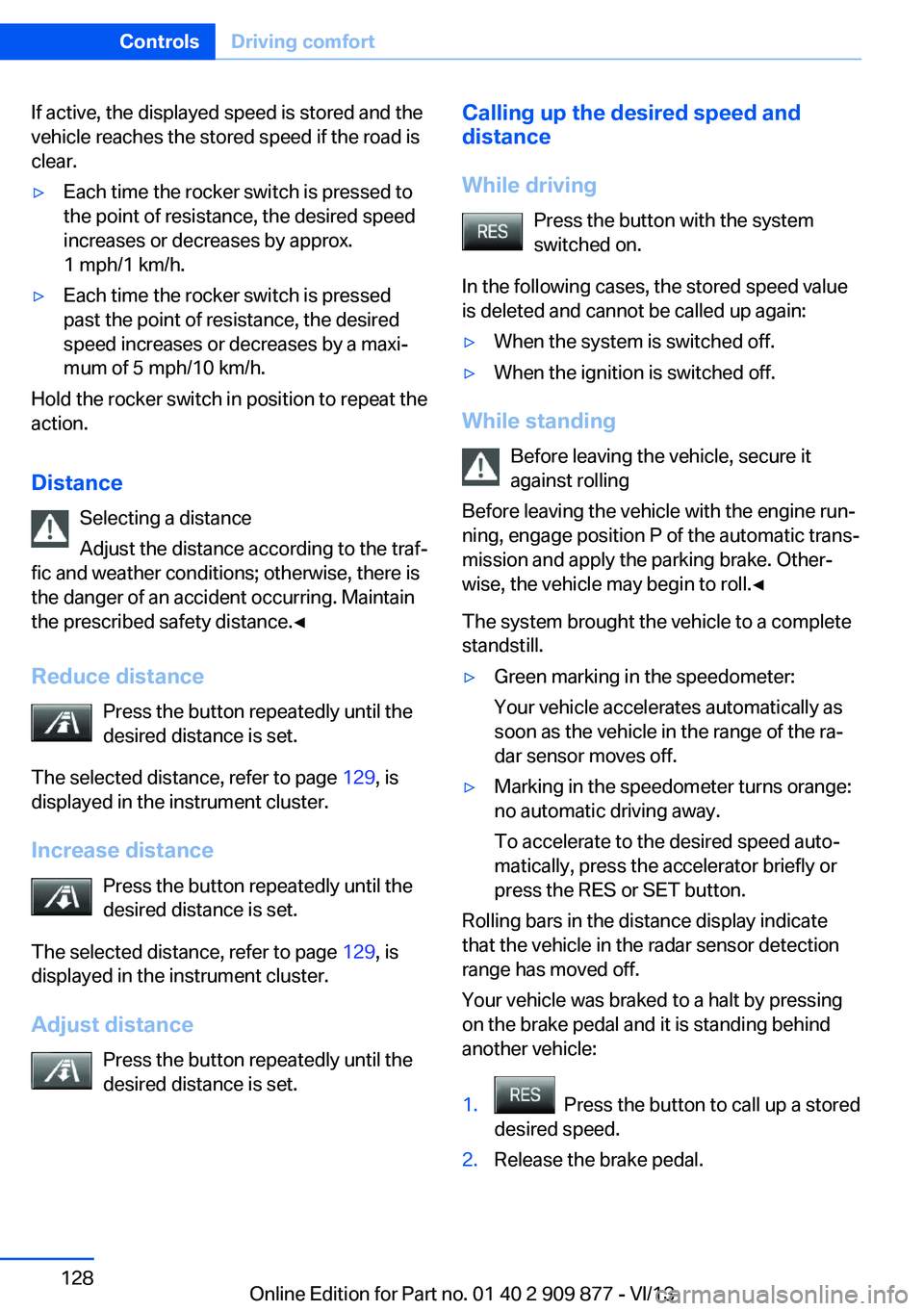
If active, the displayed speed is stored and the
vehicle reaches the stored speed if the road is
clear.▷Each time the rocker switch is pressed to
the point of resistance, the desired speed
increases or decreases by approx.
1 mph/1 km/h.▷Each time the rocker switch is pressed
past the point of resistance, the desired
speed increases or decreases by a maxi‐
mum of 5 mph/10 km/h.
Hold the rocker switch in position to repeat the
action.
Distance Selecting a distance
Adjust the distance according to the traf‐
fic and weather conditions; otherwise, there is
the danger of an accident occurring. Maintain
the prescribed safety distance.◀
Reduce distance Press the button repeatedly until the
desired distance is set.
The selected distance, refer to page 129, is
displayed in the instrument cluster.
Increase distance Press the button repeatedly until the
desired distance is set.
The selected distance, refer to page 129, is
displayed in the instrument cluster.
Adjust distance Press the button repeatedly until the
desired distance is set.
Calling up the desired speed and
distance
While driving Press the button with the system
switched on.
In the following cases, the stored speed value
is deleted and cannot be called up again:▷When the system is switched off.▷When the ignition is switched off.
While standing
Before leaving the vehicle, secure it
against rolling
Before leaving the vehicle with the engine run‐
ning, engage position P of the automatic trans‐
mission and apply the parking brake. Other‐
wise, the vehicle may begin to roll.◀
The system brought the vehicle to a complete
standstill.
▷Green marking in the speedometer:
Your vehicle accelerates automatically as
soon as the vehicle in the range of the ra‐
dar sensor moves off.▷Marking in the speedometer turns orange:
no automatic driving away.
To accelerate to the desired speed auto‐
matically, press the accelerator briefly or
press the RES or SET button.
Rolling bars in the distance display indicate
that the vehicle in the radar sensor detection
range has moved off.
Your vehicle was braked to a halt by pressing
on the brake pedal and it is standing behind
another vehicle:
1. Press the button to call up a stored
desired speed.2.Release the brake pedal.Seite 128ControlsDriving comfort128
Online Edition for Part no. 01 40 2 909 877 - VI/13
Page 131 of 243
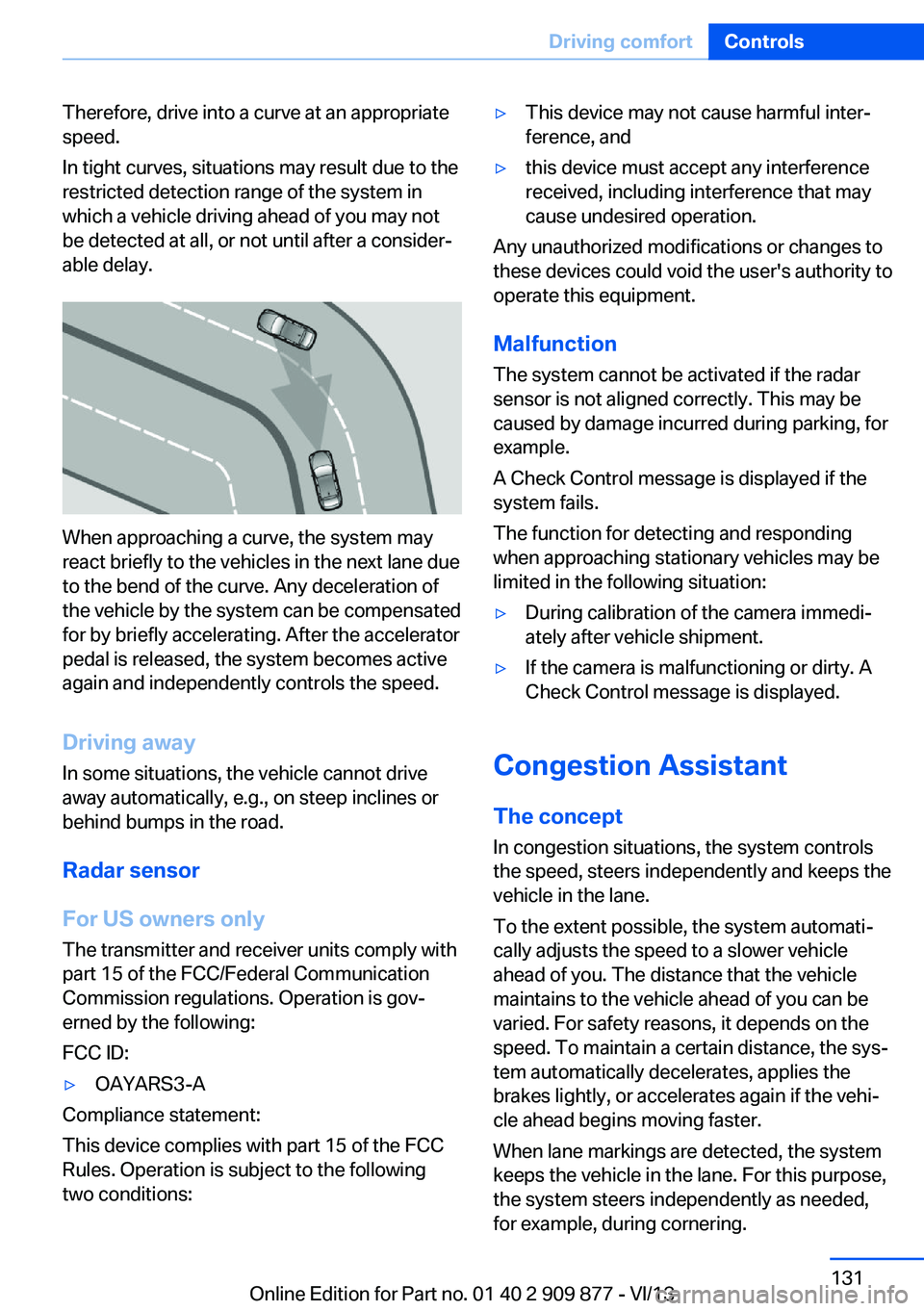
Therefore, drive into a curve at an appropriate
speed.
In tight curves, situations may result due to the
restricted detection range of the system in
which a vehicle driving ahead of you may not
be detected at all, or not until after a consider‐
able delay.
When approaching a curve, the system may
react briefly to the vehicles in the next lane due
to the bend of the curve. Any deceleration of
the vehicle by the system can be compensated
for by briefly accelerating. After the accelerator
pedal is released, the system becomes active
again and independently controls the speed.
Driving away In some situations, the vehicle cannot drive
away automatically, e.g., on steep inclines or
behind bumps in the road.
Radar sensor
For US owners only
The transmitter and receiver units comply with
part 15 of the FCC/Federal Communication
Commission regulations. Operation is gov‐
erned by the following:
FCC ID:
▷OAYARS3-A
Compliance statement:
This device complies with part 15 of the FCC
Rules. Operation is subject to the following
two conditions:
▷This device may not cause harmful inter‐
ference, and▷this device must accept any interference
received, including interference that may
cause undesired operation.
Any unauthorized modifications or changes to
these devices could void the user's authority to
operate this equipment.
Malfunction
The system cannot be activated if the radar sensor is not aligned correctly. This may be
caused by damage incurred during parking, for
example.
A Check Control message is displayed if the
system fails.
The function for detecting and responding
when approaching stationary vehicles may be limited in the following situation:
▷During calibration of the camera immedi‐
ately after vehicle shipment.▷If the camera is malfunctioning or dirty. A
Check Control message is displayed.
Congestion Assistant
The concept In congestion situations, the system controls
the speed, steers independently and keeps the
vehicle in the lane.
To the extent possible, the system automati‐
cally adjusts the speed to a slower vehicle
ahead of you. The distance that the vehicle
maintains to the vehicle ahead of you can be
varied. For safety reasons, it depends on the
speed. To maintain a certain distance, the sys‐
tem automatically decelerates, applies the
brakes lightly, or accelerates again if the vehi‐
cle ahead begins moving faster.
When lane markings are detected, the system
keeps the vehicle in the lane. For this purpose,
the system steers independently as needed,
for example, during cornering.
Seite 131Driving comfortControls131
Online Edition for Part no. 01 40 2 909 877 - VI/13
Page 145 of 243
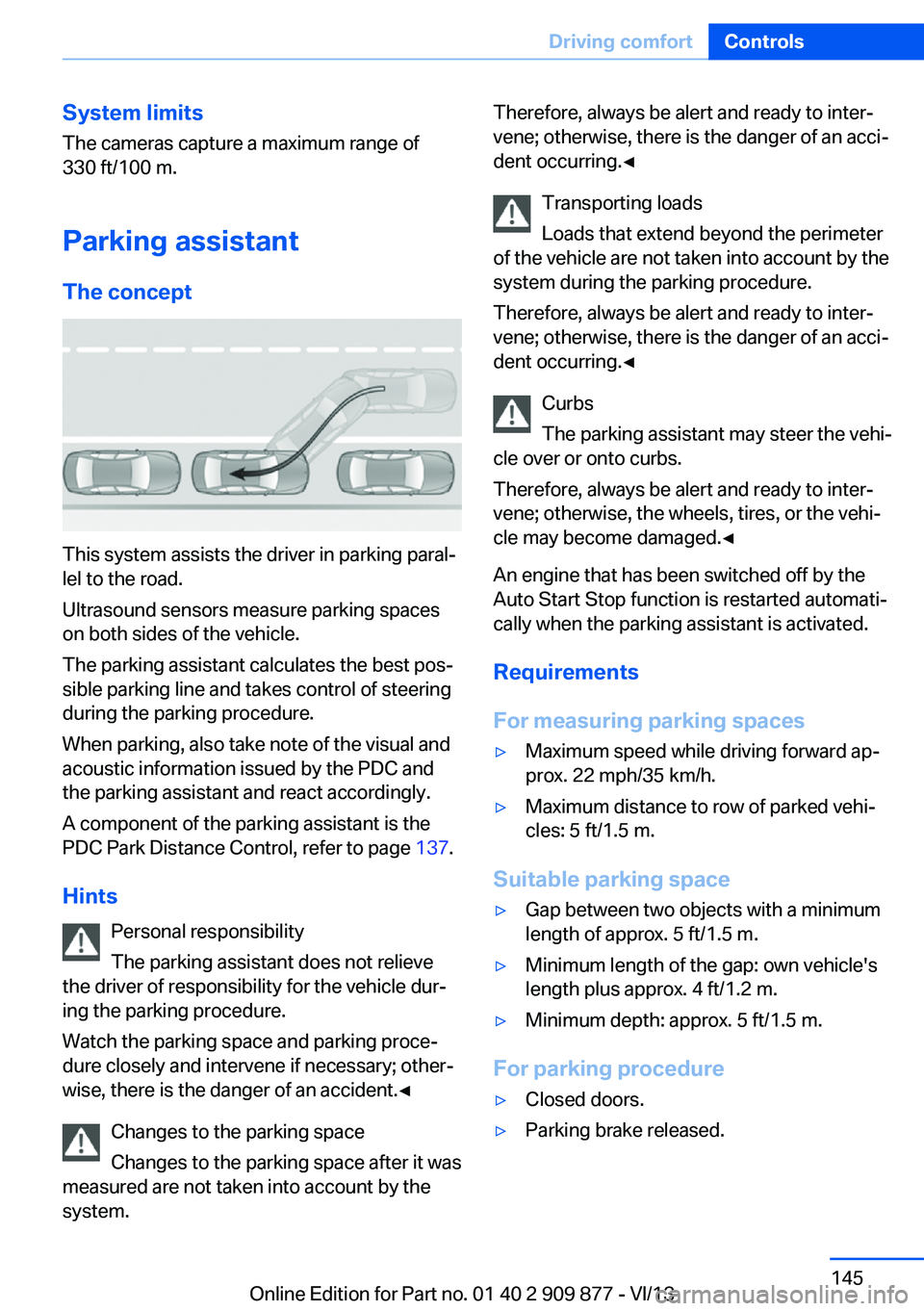
System limits
The cameras capture a maximum range of
330 ft/100 m.
Parking assistantThe concept
This system assists the driver in parking paral‐
lel to the road.
Ultrasound sensors measure parking spaces
on both sides of the vehicle.
The parking assistant calculates the best pos‐
sible parking line and takes control of steering
during the parking procedure.
When parking, also take note of the visual and
acoustic information issued by the PDC and
the parking assistant and react accordingly.
A component of the parking assistant is the
PDC Park Distance Control, refer to page 137.
Hints Personal responsibility
The parking assistant does not relieve
the driver of responsibility for the vehicle dur‐
ing the parking procedure.
Watch the parking space and parking proce‐
dure closely and intervene if necessary; other‐
wise, there is the danger of an accident.◀
Changes to the parking space
Changes to the parking space after it was
measured are not taken into account by the
system.
Therefore, always be alert and ready to inter‐
vene; otherwise, there is the danger of an acci‐
dent occurring.◀
Transporting loads
Loads that extend beyond the perimeter
of the vehicle are not taken into account by the
system during the parking procedure.
Therefore, always be alert and ready to inter‐
vene; otherwise, there is the danger of an acci‐
dent occurring.◀
Curbs
The parking assistant may steer the vehi‐
cle over or onto curbs.
Therefore, always be alert and ready to inter‐
vene; otherwise, the wheels, tires, or the vehi‐
cle may become damaged.◀
An engine that has been switched off by the
Auto Start Stop function is restarted automati‐
cally when the parking assistant is activated.
Requirements
For measuring parking spaces▷Maximum speed while driving forward ap‐
prox. 22 mph/35 km/h.▷Maximum distance to row of parked vehi‐
cles: 5 ft/1.5 m.
Suitable parking space
▷Gap between two objects with a minimum
length of approx. 5 ft/1.5 m.▷Minimum length of the gap: own vehicle's
length plus approx. 4 ft/1.2 m.▷Minimum depth: approx. 5 ft/1.5 m.
For parking procedure
▷Closed doors.▷Parking brake released.Seite 145Driving comfortControls145
Online Edition for Part no. 01 40 2 909 877 - VI/13
Page 234 of 243
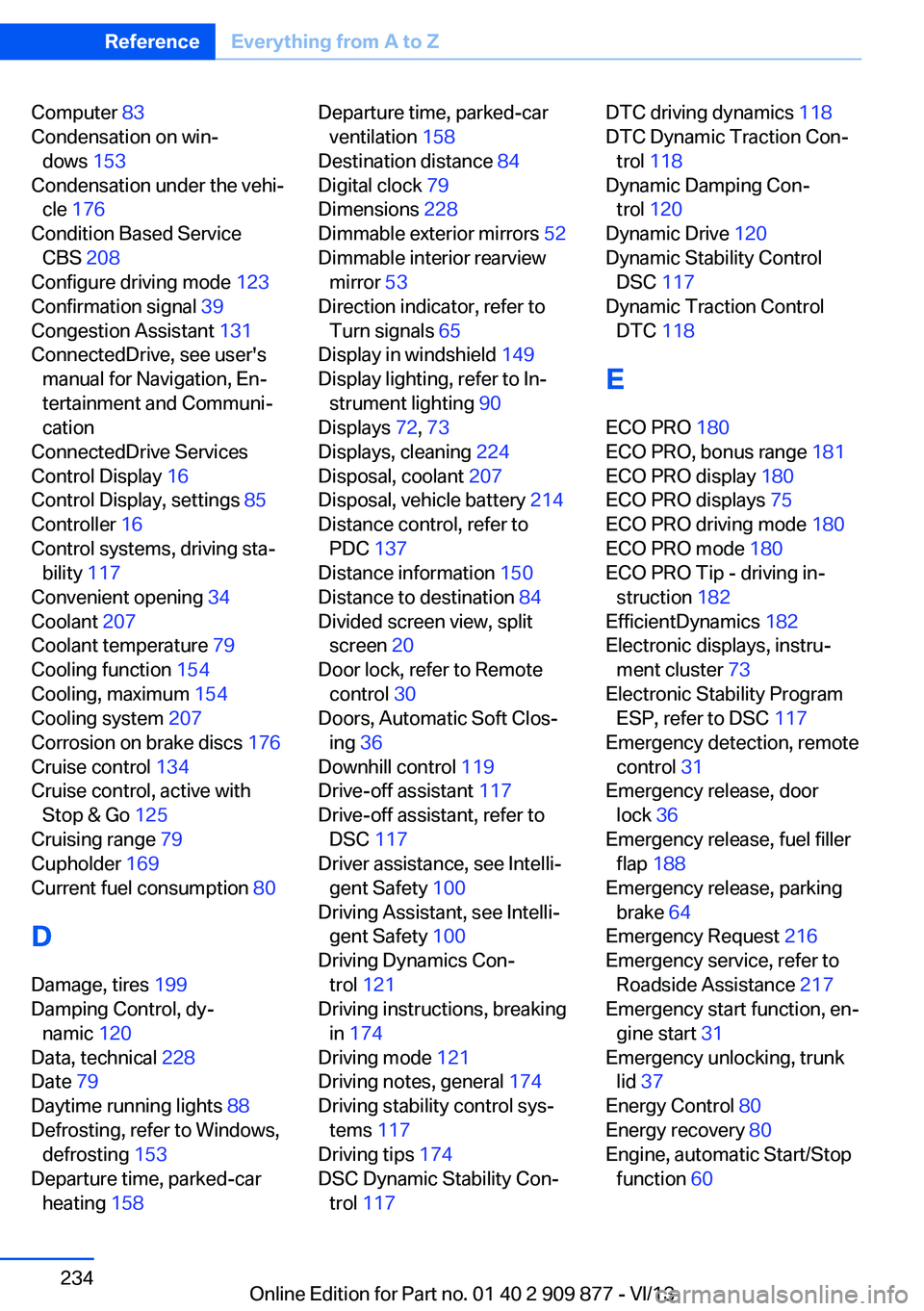
Computer 83
Condensation on win‐ dows 153
Condensation under the vehi‐ cle 176
Condition Based Service CBS 208
Configure driving mode 123
Confirmation signal 39
Congestion Assistant 131
ConnectedDrive, see user's manual for Navigation, En‐
tertainment and Communi‐
cation
ConnectedDrive Services
Control Display 16
Control Display, settings 85
Controller 16
Control systems, driving sta‐ bility 117
Convenient opening 34
Coolant 207
Coolant temperature 79
Cooling function 154
Cooling, maximum 154
Cooling system 207
Corrosion on brake discs 176
Cruise control 134
Cruise control, active with Stop & Go 125
Cruising range 79
Cupholder 169
Current fuel consumption 80
D
Damage, tires 199
Damping Control, dy‐ namic 120
Data, technical 228
Date 79
Daytime running lights 88
Defrosting, refer to Windows, defrosting 153
Departure time, parked-car heating 158 Departure time, parked-car
ventilation 158
Destination distance 84
Digital clock 79
Dimensions 228
Dimmable exterior mirrors 52
Dimmable interior rearview mirror 53
Direction indicator, refer to Turn signals 65
Display in windshield 149
Display lighting, refer to In‐ strument lighting 90
Displays 72, 73
Displays, cleaning 224
Disposal, coolant 207
Disposal, vehicle battery 214
Distance control, refer to PDC 137
Distance information 150
Distance to destination 84
Divided screen view, split screen 20
Door lock, refer to Remote control 30
Doors, Automatic Soft Clos‐ ing 36
Downhill control 119
Drive-off assistant 117
Drive-off assistant, refer to DSC 117
Driver assistance, see Intelli‐ gent Safety 100
Driving Assistant, see Intelli‐ gent Safety 100
Driving Dynamics Con‐ trol 121
Driving instructions, breaking in 174
Driving mode 121
Driving notes, general 174
Driving stability control sys‐ tems 117
Driving tips 174
DSC Dynamic Stability Con‐ trol 117 DTC driving dynamics 118
DTC Dynamic Traction Con‐ trol 118
Dynamic Damping Con‐ trol 120
Dynamic Drive 120
Dynamic Stability Control DSC 117
Dynamic Traction Control DTC 118
E
ECO PRO 180
ECO PRO, bonus range 181
ECO PRO display 180
ECO PRO displays 75
ECO PRO driving mode 180
ECO PRO mode 180
ECO PRO Tip - driving in‐ struction 182
EfficientDynamics 182
Electronic displays, instru‐ ment cluster 73
Electronic Stability Program ESP, refer to DSC 117
Emergency detection, remote control 31
Emergency release, door lock 36
Emergency release, fuel filler flap 188
Emergency release, parking brake 64
Emergency Request 216
Emergency service, refer to Roadside Assistance 217
Emergency start function, en‐ gine start 31
Emergency unlocking, trunk lid 37
Energy Control 80
Energy recovery 80
Engine, automatic Start/Stop function 60 Seite 234ReferenceEverything from A to Z234
Online Edition for Part no. 01 40 2 909 877 - VI/13
Page 235 of 243
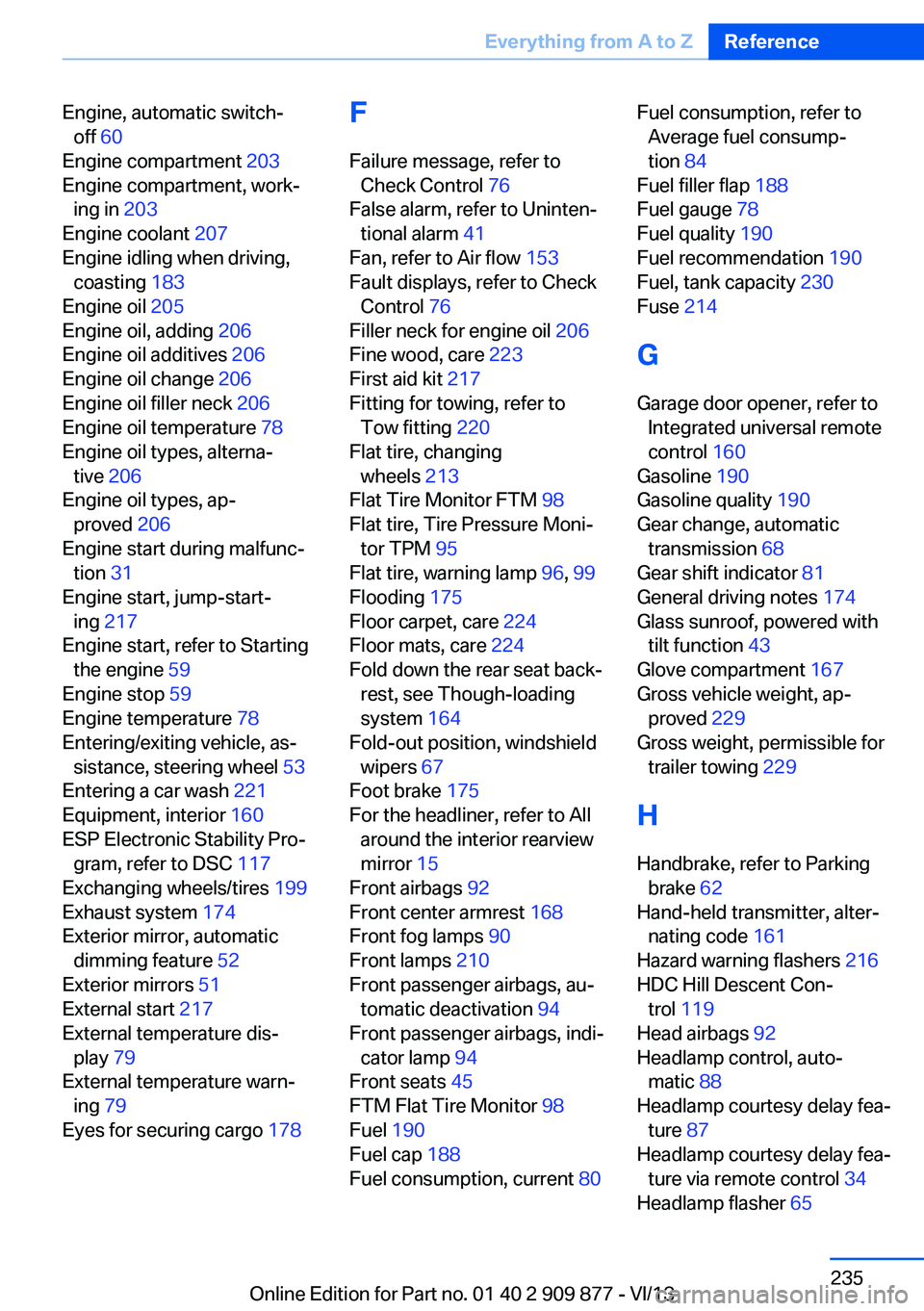
Engine, automatic switch-off 60
Engine compartment 203
Engine compartment, work‐ ing in 203
Engine coolant 207
Engine idling when driving, coasting 183
Engine oil 205
Engine oil, adding 206
Engine oil additives 206
Engine oil change 206
Engine oil filler neck 206
Engine oil temperature 78
Engine oil types, alterna‐ tive 206
Engine oil types, ap‐ proved 206
Engine start during malfunc‐ tion 31
Engine start, jump-start‐ ing 217
Engine start, refer to Starting the engine 59
Engine stop 59
Engine temperature 78
Entering/exiting vehicle, as‐ sistance, steering wheel 53
Entering a car wash 221
Equipment, interior 160
ESP Electronic Stability Pro‐ gram, refer to DSC 117
Exchanging wheels/tires 199
Exhaust system 174
Exterior mirror, automatic dimming feature 52
Exterior mirrors 51
External start 217
External temperature dis‐ play 79
External temperature warn‐ ing 79
Eyes for securing cargo 178 F
Failure message, refer to Check Control 76
False alarm, refer to Uninten‐ tional alarm 41
Fan, refer to Air flow 153
Fault displays, refer to Check Control 76
Filler neck for engine oil 206
Fine wood, care 223
First aid kit 217
Fitting for towing, refer to Tow fitting 220
Flat tire, changing wheels 213
Flat Tire Monitor FTM 98
Flat tire, Tire Pressure Moni‐ tor TPM 95
Flat tire, warning lamp 96, 99
Flooding 175
Floor carpet, care 224
Floor mats, care 224
Fold down the rear seat back‐ rest, see Though-loading
system 164
Fold-out position, windshield wipers 67
Foot brake 175
For the headliner, refer to All around the interior rearview
mirror 15
Front airbags 92
Front center armrest 168
Front fog lamps 90
Front lamps 210
Front passenger airbags, au‐ tomatic deactivation 94
Front passenger airbags, indi‐ cator lamp 94
Front seats 45
FTM Flat Tire Monitor 98
Fuel 190
Fuel cap 188
Fuel consumption, current 80 Fuel consumption, refer to
Average fuel consump‐
tion 84
Fuel filler flap 188
Fuel gauge 78
Fuel quality 190
Fuel recommendation 190
Fuel, tank capacity 230
Fuse 214
G Garage door opener, refer to Integrated universal remote
control 160
Gasoline 190
Gasoline quality 190
Gear change, automatic transmission 68
Gear shift indicator 81
General driving notes 174
Glass sunroof, powered with tilt function 43
Glove compartment 167
Gross vehicle weight, ap‐ proved 229
Gross weight, permissible for trailer towing 229
H
Handbrake, refer to Parking brake 62
Hand-held transmitter, alter‐ nating code 161
Hazard warning flashers 216
HDC Hill Descent Con‐ trol 119
Head airbags 92
Headlamp control, auto‐ matic 88
Headlamp courtesy delay fea‐ ture 87
Headlamp courtesy delay fea‐ ture via remote control 34
Headlamp flasher 65 Seite 235Everything from A to ZReference235
Online Edition for Part no. 01 40 2 909 877 - VI/13
Page 237 of 243
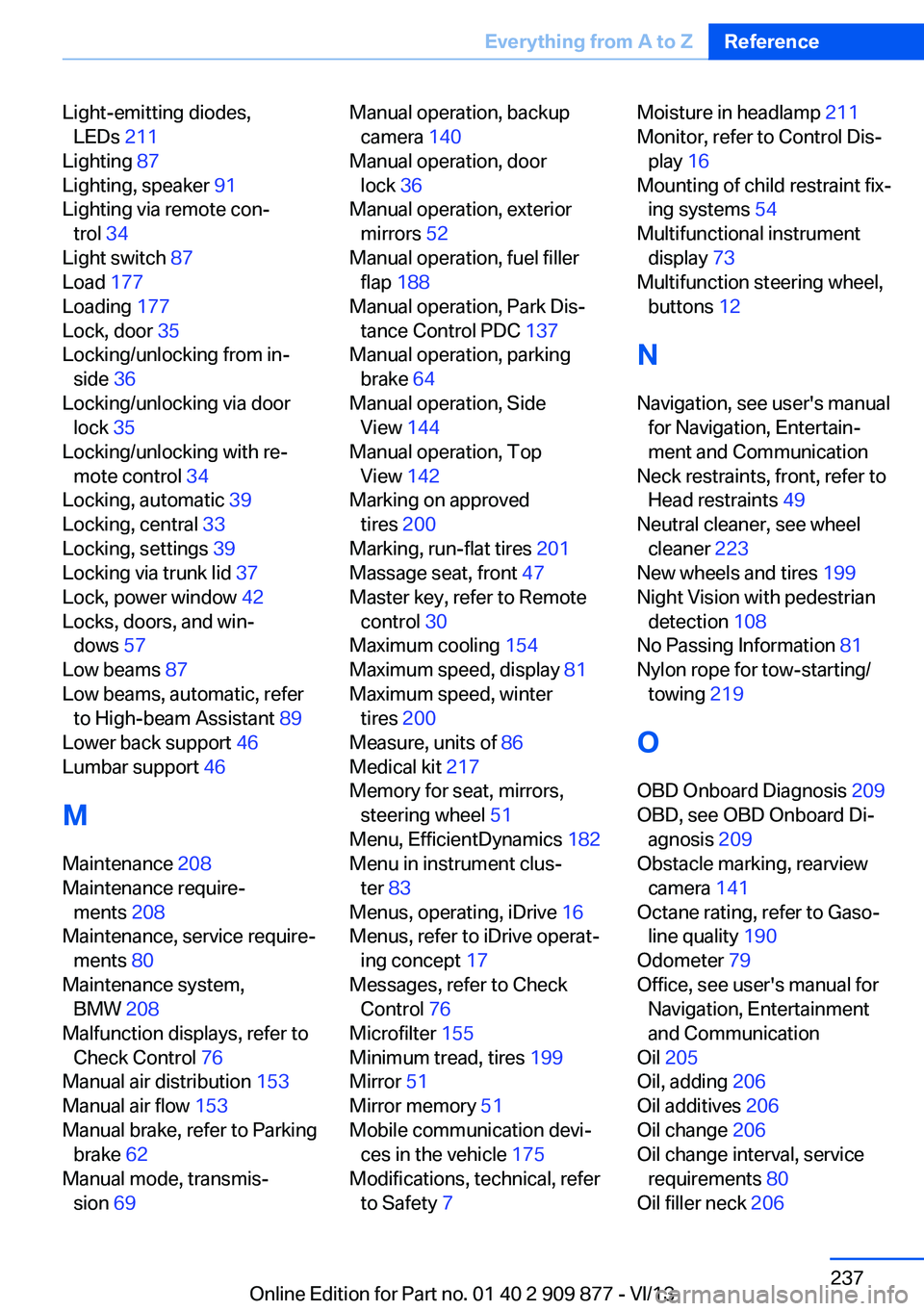
Light-emitting diodes,LEDs 211
Lighting 87
Lighting, speaker 91
Lighting via remote con‐ trol 34
Light switch 87
Load 177
Loading 177
Lock, door 35
Locking/unlocking from in‐ side 36
Locking/unlocking via door lock 35
Locking/unlocking with re‐ mote control 34
Locking, automatic 39
Locking, central 33
Locking, settings 39
Locking via trunk lid 37
Lock, power window 42
Locks, doors, and win‐ dows 57
Low beams 87
Low beams, automatic, refer to High-beam Assistant 89
Lower back support 46
Lumbar support 46
M
Maintenance 208
Maintenance require‐ ments 208
Maintenance, service require‐ ments 80
Maintenance system, BMW 208
Malfunction displays, refer to Check Control 76
Manual air distribution 153
Manual air flow 153
Manual brake, refer to Parking brake 62
Manual mode, transmis‐ sion 69 Manual operation, backup
camera 140
Manual operation, door lock 36
Manual operation, exterior mirrors 52
Manual operation, fuel filler flap 188
Manual operation, Park Dis‐ tance Control PDC 137
Manual operation, parking brake 64
Manual operation, Side View 144
Manual operation, Top View 142
Marking on approved tires 200
Marking, run-flat tires 201
Massage seat, front 47
Master key, refer to Remote control 30
Maximum cooling 154
Maximum speed, display 81
Maximum speed, winter tires 200
Measure, units of 86
Medical kit 217
Memory for seat, mirrors, steering wheel 51
Menu, EfficientDynamics 182
Menu in instrument clus‐ ter 83
Menus, operating, iDrive 16
Menus, refer to iDrive operat‐ ing concept 17
Messages, refer to Check Control 76
Microfilter 155
Minimum tread, tires 199
Mirror 51
Mirror memory 51
Mobile communication devi‐ ces in the vehicle 175
Modifications, technical, refer to Safety 7 Moisture in headlamp 211
Monitor, refer to Control Dis‐ play 16
Mounting of child restraint fix‐ ing systems 54
Multifunctional instrument display 73
Multifunction steering wheel, buttons 12
N Navigation, see user's manual for Navigation, Entertain‐
ment and Communication
Neck restraints, front, refer to Head restraints 49
Neutral cleaner, see wheel cleaner 223
New wheels and tires 199
Night Vision with pedestrian detection 108
No Passing Information 81
Nylon rope for tow-starting/ towing 219
O OBD Onboard Diagnosis 209
OBD, see OBD Onboard Di‐ agnosis 209
Obstacle marking, rearview camera 141
Octane rating, refer to Gaso‐ line quality 190
Odometer 79
Office, see user's manual for Navigation, Entertainment
and Communication
Oil 205
Oil, adding 206
Oil additives 206
Oil change 206
Oil change interval, service requirements 80
Oil filler neck 206 Seite 237Everything from A to ZReference237
Online Edition for Part no. 01 40 2 909 877 - VI/13
Page 238 of 243
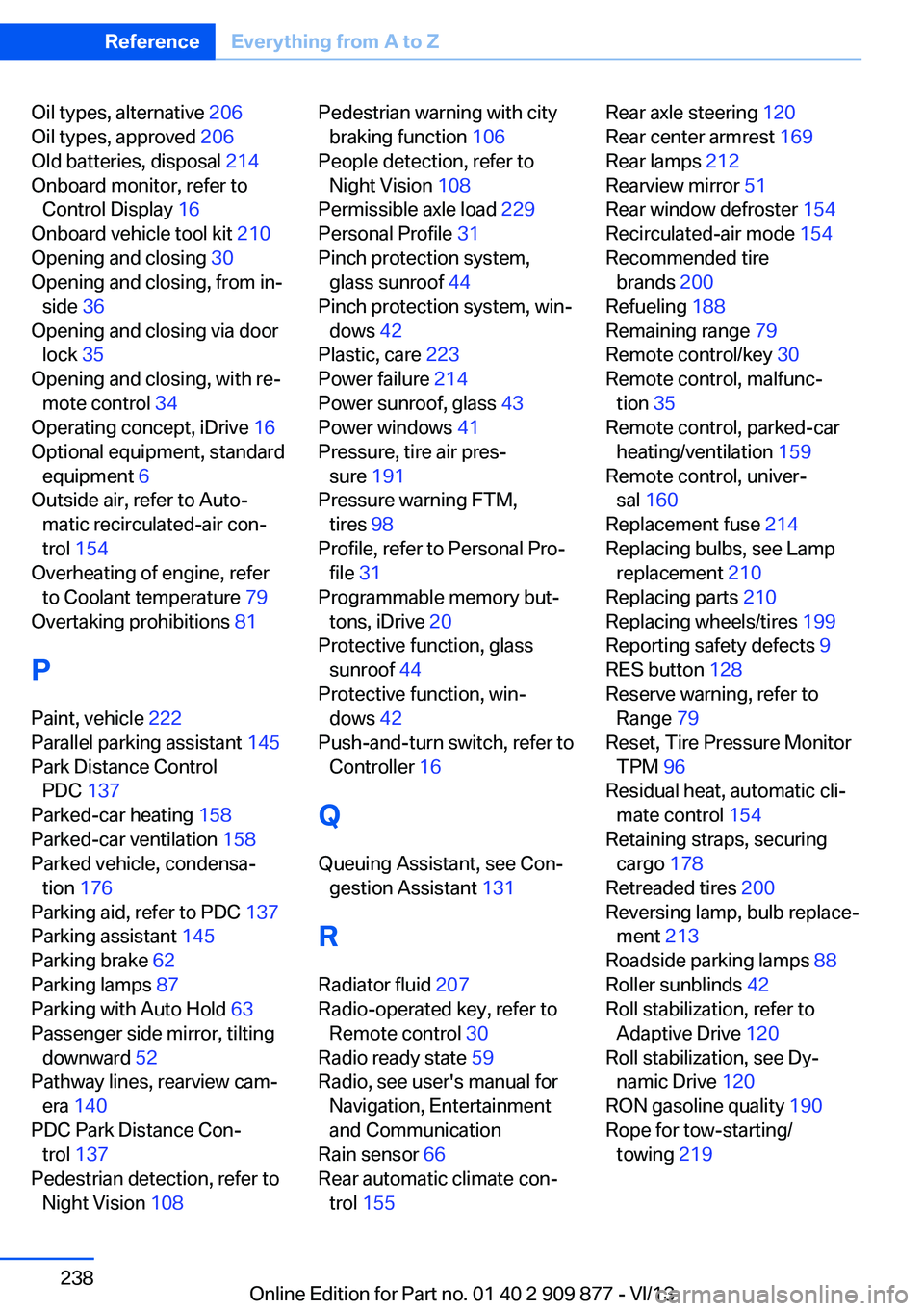
Oil types, alternative 206
Oil types, approved 206
Old batteries, disposal 214
Onboard monitor, refer to Control Display 16
Onboard vehicle tool kit 210
Opening and closing 30
Opening and closing, from in‐ side 36
Opening and closing via door lock 35
Opening and closing, with re‐ mote control 34
Operating concept, iDrive 16
Optional equipment, standard equipment 6
Outside air, refer to Auto‐ matic recirculated-air con‐
trol 154
Overheating of engine, refer to Coolant temperature 79
Overtaking prohibitions 81
P Paint, vehicle 222
Parallel parking assistant 145
Park Distance Control PDC 137
Parked-car heating 158
Parked-car ventilation 158
Parked vehicle, condensa‐ tion 176
Parking aid, refer to PDC 137
Parking assistant 145
Parking brake 62
Parking lamps 87
Parking with Auto Hold 63
Passenger side mirror, tilting downward 52
Pathway lines, rearview cam‐ era 140
PDC Park Distance Con‐ trol 137
Pedestrian detection, refer to Night Vision 108 Pedestrian warning with city
braking function 106
People detection, refer to Night Vision 108
Permissible axle load 229
Personal Profile 31
Pinch protection system, glass sunroof 44
Pinch protection system, win‐ dows 42
Plastic, care 223
Power failure 214
Power sunroof, glass 43
Power windows 41
Pressure, tire air pres‐ sure 191
Pressure warning FTM, tires 98
Profile, refer to Personal Pro‐ file 31
Programmable memory but‐ tons, iDrive 20
Protective function, glass sunroof 44
Protective function, win‐ dows 42
Push-and-turn switch, refer to Controller 16
Q Queuing Assistant, see Con‐ gestion Assistant 131
R Radiator fluid 207
Radio-operated key, refer to Remote control 30
Radio ready state 59
Radio, see user's manual for Navigation, Entertainment
and Communication
Rain sensor 66
Rear automatic climate con‐ trol 155 Rear axle steering 120
Rear center armrest 169
Rear lamps 212
Rearview mirror 51
Rear window defroster 154
Recirculated-air mode 154
Recommended tire brands 200
Refueling 188
Remaining range 79
Remote control/key 30
Remote control, malfunc‐ tion 35
Remote control, parked-car heating/ventilation 159
Remote control, univer‐ sal 160
Replacement fuse 214
Replacing bulbs, see Lamp replacement 210
Replacing parts 210
Replacing wheels/tires 199
Reporting safety defects 9
RES button 128
Reserve warning, refer to Range 79
Reset, Tire Pressure Monitor TPM 96
Residual heat, automatic cli‐ mate control 154
Retaining straps, securing cargo 178
Retreaded tires 200
Reversing lamp, bulb replace‐ ment 213
Roadside parking lamps 88
Roller sunblinds 42
Roll stabilization, refer to Adaptive Drive 120
Roll stabilization, see Dy‐ namic Drive 120
RON gasoline quality 190
Rope for tow-starting/ towing 219 Seite 238ReferenceEverything from A to Z238
Online Edition for Part no. 01 40 2 909 877 - VI/13